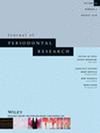Influence of mobility on the long-term risk of tooth extraction/loss in periodontitis patients. A systematic review and meta-analysis
Abstract
The aim of this systematic review (SR) was to assess whether tooth mobility (TM) increases the risk of tooth extraction/loss. The protocol was registered in PROSPERO database (CRD42023485425). The focused PECO questions were as follows: (1) “In patients with periodontitis, undergoing periodontal treatment, are teeth affected by mobility at higher risk of being extracted/lost compared to non-mobile teeth, with a minimum follow-up of 10 years?” and (2) “In these patients, does varying degrees of tooth mobility increase the risk of tooth extraction/loss, with a minimum follow-up of 10 years?”. Results were reported according to PRISMA statement. Electronic and manual searches were conducted to identify longitudinal studies. The different assessments of tooth mobility were pooled into three groups: TM0: Undetectable tooth mobility, TM1: Horizontal/Mesio-distal mobility ≤1 mm, TM2: Horizontal/Mesio-distal mobility >1 mm or vertical tooth mobility. Tooth loss was the primary outcome. Various meta-analyses were conducted, including subgroup analyses considering different follow-up lengths and the timing of TM assessment, along with sensitivity analyses. A trial sequential analysis was also performed. Eleven studies were included (1883 patients). The mean follow-up range was 10–25 years. The weighted total of included teeth, based on the sample size, was 18 918, with a total of 1604 (8.47%) extracted/lost teeth. The overall rate of tooth extraction/loss increased with increasing mobility: TM0 was associated with a 5.85% rate (866/14822), TM1 with the 11.8% (384/3255), TM2 with the 40.3% (339/841). Mobile teeth (TM1/TM2) were at an increased risk for tooth extraction/loss, compared to TM0 (HR: 2.85; [95% CI 1.88–4.32]; p < .00001). TM1 had a higher risk than TM0 (HR: 1.96; [95% CI 1.09–3.53]; p < .00001). TM2 had a higher risk than TM1 (HR: 2.85; [95% CI 2.19–3.70]; p < .00001) and TM0 (HR: 7.12; [95% CI 3.27–15.51]; p < .00001). The results of the tests for subgroup differences were not significant. Sensitivity meta-analyses yielded consistent results with other meta-analyses. Within the limits of the quality of the studies included in the meta-analyses, mobile teeth were at higher risk of being extracted/lost in the long-term and higher degrees of TM significantly influenced clinicians‘ decision to extract a tooth. However, most teeth can be retained in the long-term and thus TM should not be considered a reason for extraction or a risk factor for tooth loss, regardless of the degree of TM.

 求助内容:
求助内容: 应助结果提醒方式:
应助结果提醒方式:


